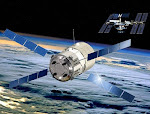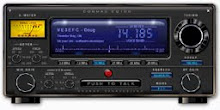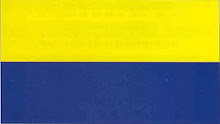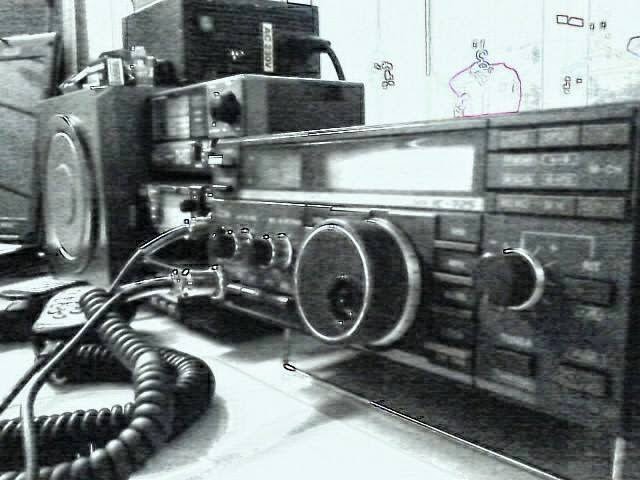This new image from the Solar Dynamics Observatory’s Atmospheric Imaging Assembly (AIA) shows in great detail a solar prominence taken from a March 30, 2010 eruption. The twisting motion of the material is the most noticeable feature. Launched on Feb. 11, 2010, SDO is the most advanced spacecraft ever designed to study the sun. During its five-year mission, it will examine the sun's magnetic field and also provide a better understanding of the role the sun plays in Earth's atmospheric chemistry and climate. Since launch, engineers have been conducting testing and verification of the spacecraft’s components. Now fully operational, SDO will provide images with clarity 10 times better than high-definition television and will return more comprehensive science data faster than any other solar observing spacecraft.
SEE AND HEAR MORSE CODE
ASTRA Malaysia
Thursday, April 29, 2010
Image Of The Day
This new image from the Solar Dynamics Observatory’s Atmospheric Imaging Assembly (AIA) shows in great detail a solar prominence taken from a March 30, 2010 eruption. The twisting motion of the material is the most noticeable feature. Launched on Feb. 11, 2010, SDO is the most advanced spacecraft ever designed to study the sun. During its five-year mission, it will examine the sun's magnetic field and also provide a better understanding of the role the sun plays in Earth's atmospheric chemistry and climate. Since launch, engineers have been conducting testing and verification of the spacecraft’s components. Now fully operational, SDO will provide images with clarity 10 times better than high-definition television and will return more comprehensive science data faster than any other solar observing spacecraft.
Image Credit: NASA/SDO/AIA
Latest IceBridge Campaign News
 In just over four weeks, scientists and crew have flown 14 successful missions over the Arctic Ocean and the Greenland Ice Sheet for more than 120 airtime hours, flying a distance greater than 1.5 times around the world. › Learn More
In just over four weeks, scientists and crew have flown 14 successful missions over the Arctic Ocean and the Greenland Ice Sheet for more than 120 airtime hours, flying a distance greater than 1.5 times around the world. › Learn MoreScientists Say Ice Lurks in Asteroid's Cold Heart
 Using a NASA funded telescope, Scientists have detected water-ice and carbon-based organic compounds on the surface of an asteroid, suggesting that some asteroids and comets were the water carriers for a primordial Earth. › Learn More
Using a NASA funded telescope, Scientists have detected water-ice and carbon-based organic compounds on the surface of an asteroid, suggesting that some asteroids and comets were the water carriers for a primordial Earth. › Learn MoreThursday, April 22, 2010
NASA's New Eye on the Sun Delivers Stunning First Images
 NASA's Solar Dynamics Observatory is returning early images that confirm an unprecedented new capability for understanding our sun's dynamic processes and effects on Earth. › Read More › Media Resources
NASA's Solar Dynamics Observatory is returning early images that confirm an unprecedented new capability for understanding our sun's dynamic processes and effects on Earth. › Read More › Media ResourcesWednesday, April 21, 2010
Monday, April 19, 2010
STEREO Captures Huge Eruptive Prominence
 The STEREO (Ahead) spacecraft caught a spectacular eruptive prominence in extreme UV light. The prominence appears to stretch almost halfway across the sun, about 50 million miles. › Read More › Download Video
The STEREO (Ahead) spacecraft caught a spectacular eruptive prominence in extreme UV light. The prominence appears to stretch almost halfway across the sun, about 50 million miles. › Read More › Download VideoSunday, April 18, 2010
Bengkel Antenna 5/8 @ Astra @ Kaki Biawak
 Bengkel Antenna 5/8 @ Astra @ Kaki Biawak akan diadakan pada 24 April 2010 bertempat di No. 186, Fasa 4, Bandar Perdana, Sungai Petani, Kedah, jam 8.30 malam dengan bayaran RM25.00 (Bahan-bahan untuk penyediaan Antenna akan disediakan). Kepada rakan-rakan Radio Amatur yang berminat di jemput hadir. Walau bagaimanapun bagi peserta-peserta yang berminat juga diharap dapat mengesahkan penyertaan dengan SEGERA bagi tujuan pembelian bahan-bahan, kerana bahan-bahan hanya akan disediakan mengikut jumlah peserta. Sebarang pertanyaan / pengesahan dan bayaran (Sebelum atau pada 20 April 2010) harap hubungi 9W2XAN (012-4469486), 9W2JGR (017-5512949) dan 9W2CJK (017-4532250). Sekian harap maklum. 73s.
Bengkel Antenna 5/8 @ Astra @ Kaki Biawak akan diadakan pada 24 April 2010 bertempat di No. 186, Fasa 4, Bandar Perdana, Sungai Petani, Kedah, jam 8.30 malam dengan bayaran RM25.00 (Bahan-bahan untuk penyediaan Antenna akan disediakan). Kepada rakan-rakan Radio Amatur yang berminat di jemput hadir. Walau bagaimanapun bagi peserta-peserta yang berminat juga diharap dapat mengesahkan penyertaan dengan SEGERA bagi tujuan pembelian bahan-bahan, kerana bahan-bahan hanya akan disediakan mengikut jumlah peserta. Sebarang pertanyaan / pengesahan dan bayaran (Sebelum atau pada 20 April 2010) harap hubungi 9W2XAN (012-4469486), 9W2JGR (017-5512949) dan 9W2CJK (017-4532250). Sekian harap maklum. 73s.Wednesday, April 14, 2010
Image Of The Day
Dwarfed by space shuttle Discovery and with Earth's horizon and the blackness of space providing the backdrop for the scene, NASA astronauts Rick Mastracchio (right) and Clayton Anderson worked in Discovery's aft payload bay during the mission's third and final spacewalk. During the six-hour, 24-minute spacewalk, Mastracchio and Anderson hooked up fluid lines of the new 1,700-pound tank, retrieved some micrometeoroid shields from the Quest airlock's exterior, relocated a portable foot restraint and prepared cables on the Zenith 1 truss for a spare Space to Ground Ku-Band antenna, two chores required before space shuttle Atlantis' STS-132/ULF-4 mission in May.
Image Credit: NASA
Final Transfers and News Conference for Crews
 With the spacewalks complete, the crews worked on completing equipment and science experiment transfers.
With the spacewalks complete, the crews worked on completing equipment and science experiment transfers. Mastracchio and Anderson complete the installation of an ammonia tank during the final spacewalk, which began at 2:14 a.m. EDT. › Shuttle Section › HD Launch Video › TV Schedule › Comments
Mastracchio and Anderson complete the installation of an ammonia tank during the final spacewalk, which began at 2:14 a.m. EDT. › Shuttle Section › HD Launch Video › TV Schedule › Comments Tuesday, April 13, 2010
Spacewalkers "Camping Out" in Airlock

Discovery crew continues to transfer items from the Leonardo Multi-Purpose Logistics Module and prepare for the final spacewalk. › Shuttle Section › HD Launch Video › TV Schedule › Comments http://twitter.com/NASA_Astronauts
 Image above: The aft section of the docked space shuttle Discovery and the station's robotic Canadarm2 are featured in this image photographed by an STS-131 crew member on the International Space Station. The Red Sea, Sinai Peninsula (center) and Nile River (left) are seen approximately 215 miles below. Image credit: NASA -->› Meet the STS-131 Crew
Image above: The aft section of the docked space shuttle Discovery and the station's robotic Canadarm2 are featured in this image photographed by an STS-131 crew member on the International Space Station. The Red Sea, Sinai Peninsula (center) and Nile River (left) are seen approximately 215 miles below. Image credit: NASA -->› Meet the STS-131 CrewMonday, April 12, 2010
Image Of The Day
During the second spacewalk of the STS-131 mission, NASA astronauts Rick Mastracchio and Clayton Anderson (out of frame) unhooked and removed the depleted ammonia tank and installed a 1,700-pound replacement on the station’s Starboard 1 truss. This was the second of three spacewalks in the coolant tank replacement process.
Image Credit: NASA
Friday, April 9, 2010
Clayton Anderson and Rick Mastracchio prepare to perform STS-131 mission's first spacewalk.
 Clayton Anderson and Rick Mastracchio prepare to perform STS-131 mission's first spacewalk.› Shuttle Section › HD Launch Video › TV Schedule › Comments › @NASA_Astronauts
Clayton Anderson and Rick Mastracchio prepare to perform STS-131 mission's first spacewalk.› Shuttle Section › HD Launch Video › TV Schedule › Comments › @NASA_AstronautsImage Of The Day
This view of the underside of the crew cabin of the space shuttle Discovery was provided by the Expedition 23 crew during a survey as STS-131 approached the International Space Station. As part of the survey and part of every mission's activities, Discovery performed a back-flip for the rendezvous pitch maneuver (RPM). The image was photographed with a digital still camera, using a 400mm lens at a distance of about 600 feet (180 meters).
Image Credit: NASA
Tuesday, April 6, 2010
Image Of The Day
 Space shuttle Discovery's engines ignited at 6:21 a.m. EDT Monday, April 5, for liftoff of the STS-131 mission from Launch Pad 39A at NASA's Kennedy Space Center. The seven-member crew will deliver the multi-purpose logistics module Leonardo, filled with supplies, a new crew sleeping quarters and science racks that will be transferred to the International Space Station's laboratories. The crew also will switch out a gyroscope on the station’s truss, install a spare ammonia storage tank and retrieve a Japanese experiment from the station’s exterior. STS-131 is the 33rd shuttle mission to the station and the 131st shuttle mission.
Space shuttle Discovery's engines ignited at 6:21 a.m. EDT Monday, April 5, for liftoff of the STS-131 mission from Launch Pad 39A at NASA's Kennedy Space Center. The seven-member crew will deliver the multi-purpose logistics module Leonardo, filled with supplies, a new crew sleeping quarters and science racks that will be transferred to the International Space Station's laboratories. The crew also will switch out a gyroscope on the station’s truss, install a spare ammonia storage tank and retrieve a Japanese experiment from the station’s exterior. STS-131 is the 33rd shuttle mission to the station and the 131st shuttle mission.Image Credit: NASA/Troy Cryder
Monday, April 5, 2010
New Expedition 23 Crew Members Welcomed Aboard Station
 Three new flight engineers docked to the International Space Station aboard a Russian Soyuz TMA-18 spacecraft at 1:25 a.m. EDT Sunday, completing the Expedition 23 crew. › Station Section
Three new flight engineers docked to the International Space Station aboard a Russian Soyuz TMA-18 spacecraft at 1:25 a.m. EDT Sunday, completing the Expedition 23 crew. › Station SectionSunday, April 4, 2010
IV Water Filter May Open Medical Options for Astronauts
 Technology for a water filtration system will get a major test during the STS-131 mission as it is called on to create water clean enough to be used intravenously, commonly referred to as an IV. › Learn More
Technology for a water filtration system will get a major test during the STS-131 mission as it is called on to create water clean enough to be used intravenously, commonly referred to as an IV. › Learn MoreFriday, April 2, 2010
Thursday, April 1, 2010
Image Of The Day
On April 1, 1960, a satellite designed by the Radio Corporation of America (RCA) launched to become the nation's first weather satellite. That satellite, the Television InfraRed Observational Satellite, or TIROS 1, operated for only 78 days but demonstrated the feasibility of monitoring Earth's cloud cover and weather patterns from space. This NASA program provided the first accurate weather forecasts based on data gathered from space. In this image, TIROS undergoes vibration testing at the Astro-Electronic Products Division of RCA in Princeton, New Jersey. Image Credit: NASA
Discovery 'GO' For April Launch
 The STS-131 crew will deliver a multi-purpose logistics module filled with science racks and perform three spacewalks at the orbital outpost, during its April mission. › Shuttle Section › Timeline › Share Comments › @NASA_Astronauts Twitter
The STS-131 crew will deliver a multi-purpose logistics module filled with science racks and perform three spacewalks at the orbital outpost, during its April mission. › Shuttle Section › Timeline › Share Comments › @NASA_Astronauts TwitterSoyuz Set for Launch; Station Crew Prepares for Space Travelers
 New Expedition 23 flight engineers Alexander Skvortsov, Tracy Caldwell Dyson and Mikhail Kornienko will launch to the International Space Station on April 2. › Station Section
New Expedition 23 flight engineers Alexander Skvortsov, Tracy Caldwell Dyson and Mikhail Kornienko will launch to the International Space Station on April 2. › Station SectionExploring the Carina Nebula by Touch
 Hubble's glimpse of the Carina Nebula is a feast for the eyes, where young stars sculpt a fantasy landscape of valleys and pillars. A new book brings this celestial fantasy into view for those who cannot explore the image by sight. › Learn More
Hubble's glimpse of the Carina Nebula is a feast for the eyes, where young stars sculpt a fantasy landscape of valleys and pillars. A new book brings this celestial fantasy into view for those who cannot explore the image by sight. › Learn MoreUlu Legong - Hot Spring Recreation Center
 Ulu Legong is about 30 km drive to the North-East of Baling. Baling Town lies to the south east of Kedah State. This natural hot water spring has upgraded its facilities for the convenience of visitors. Overnight accommodation is provided here. It is always fascinating to shower one self with the natural hot spring water and wonder how it came to be. Many will attest to some healing properties from the mineral rich water that is attributed to hot springs here and throughout Malaysia. Children will definitely have a good time.
Ulu Legong is about 30 km drive to the North-East of Baling. Baling Town lies to the south east of Kedah State. This natural hot water spring has upgraded its facilities for the convenience of visitors. Overnight accommodation is provided here. It is always fascinating to shower one self with the natural hot spring water and wonder how it came to be. Many will attest to some healing properties from the mineral rich water that is attributed to hot springs here and throughout Malaysia. Children will definitely have a good time.Lasor Eco Park
 4WD enthusiasts converge upon this thrill in the quest for awesome challenge and exciting exploration amidst the remote, dense forest haven. Located within the Ulu Muda Eco Park, Lasor affords much more super obstacles that demand extreme endurance, perseverance, energy and ingenuity to achieve personal triumph.
4WD enthusiasts converge upon this thrill in the quest for awesome challenge and exciting exploration amidst the remote, dense forest haven. Located within the Ulu Muda Eco Park, Lasor affords much more super obstacles that demand extreme endurance, perseverance, energy and ingenuity to achieve personal triumph.The journey from Alor Star takes 1 hour 45 minutes or just 30 minutes from Baling to Kampung Lubuk Pelanduk where there would be the services of 4WD vehicles only to take visitors for another 11km to the Park.
Facilities provided here are the dining hall, surau, bathrooms, as well as areas for recreational, motivational and physical activities. Also available are long-house, chalet and camping accommodation. Besides 4x4 endurance challenge, activities that could be carried out here are forest ecology and wildlife studies. Best of all, visitors are accessible to forest, river and hill explorations.
Subscribe to:
Posts (Atom)
MyEQSLCard

eQSL Card (Recieved)
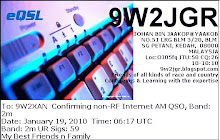
igq107 QSL Card





THE POSTCARD CROSSING PROJECT
ABOUT AMATEUR RADIO
Amateur radio service is defined in the Communication and Multimedia (Spectrum) Regulations 2000 as a radiocommunications service (covering both terrestrial and satellite) in which a station is used for the purpose of self traning, intercommunication and technical investigations carried out by authorized persons who are interested in radio technique solely with a personal aim and without any pecuniary interest.
AMATEUR RADIO OPERATOR'S CERTIFICATE
Regulation 27(1) of the Communications and Multimedia (Technical Standards) Regulations 2000 states that no person shall undertake or conduct any activity in designated skil area unless that person is certified. Amateur radio operator has been gazetted as a designated skill area category under the regulation, hence to operate an amateur radio station a person needs to have an appropriate proficiency and skill i.e. certified in this area.
INTERFERENCE
Please ensure that the radio transmision does not cause interference to any other radio services. Regulation 15(1) of the Communications and Multemedia (Technical Standards) Regulations 2000 states that no person shall intentionally design, install, operate, maintain or modify any communications equipment in a manner is likely to cause interference with, impairment, mulfunction of, or harm to any communications equipment or any other equipment.
Regulation 15(2) of the regulation denotes that a person who contravenes this regulation commits an offence and shall, on conviction, be liable to a fine not exceeding three hundred thousand ringgit (RM 300,000.00) or to imprisonment for a term of not exceeding three years or to both.
To eliminate the potential of interferences, the following procedures must be followed strictly:-
a) Ensure that suffient equipment, tools and test gear is available and can used to monitor and verify that your transmission does not cause any interference to other radio services.
b) You must responsible if your amateur radio is found to be the caused of interference. Immediate remedy action must be taken to rectify the problems in case of interference.
c) Ensure that the transmission do not exceed the level of over deviation.
d) Ensure that the radiated energy is always within the narrowest posible frequency bands for any class of emission in use.
e) The radiation of harmonics and spurious emissions should be suppressed to minimize interference.
Regulation 15(2) of the regulation denotes that a person who contravenes this regulation commits an offence and shall, on conviction, be liable to a fine not exceeding three hundred thousand ringgit (RM 300,000.00) or to imprisonment for a term of not exceeding three years or to both.
To eliminate the potential of interferences, the following procedures must be followed strictly:-
a) Ensure that suffient equipment, tools and test gear is available and can used to monitor and verify that your transmission does not cause any interference to other radio services.
b) You must responsible if your amateur radio is found to be the caused of interference. Immediate remedy action must be taken to rectify the problems in case of interference.
c) Ensure that the transmission do not exceed the level of over deviation.
d) Ensure that the radiated energy is always within the narrowest posible frequency bands for any class of emission in use.
e) The radiation of harmonics and spurious emissions should be suppressed to minimize interference.
Historical Description of Amateur Radio: From the Encyclopedia Britannica:-
Interest in amateur radio arose around the turn of the century, shortly after the Italian inventor Guglielmo Marconi successfully sent the first transatlantic wireless signal in 1901. The interference of amateur broadcasts with commercial and military transmissions led to the institution of government control in 1911. After World War I, amateurs became active in radio experimentation, contributing to developments in long-distance broadcasting and becoming the first radio operators successfully to exploit the upper medium-frequency and lower high-frequency radio bands. Over the years, amateur radio operators have also provided emergency communications during forest fires, floods, hurricanes, and other disasters. They serve as an important link between stricken communities and the outside world until normal communications are reestablished.Amateur radio operators in the United States are subject to international and federal regulations. There are five classes of licenses. Competence in the use of the International Morse Code and a knowledge of radio theory and regulation are required to obtain the advanced-level licenses. Amateur radio is allocated frequencies at the extreme high-frequency end of the medium-wave band, five groups of frequencies in the shortwave band, two groups in the veryhigh-frequency band, three in the ultrahigh-frequency band, and seven in the superhigh-frequency band for telegraphic and telephonic communication using amplitude and frequency modulation. There are restrictions on the power of the transmitters, and certain of the frequencies must be shared with due regard for the needs of other users.








































